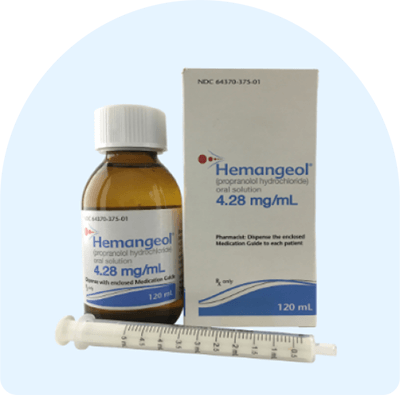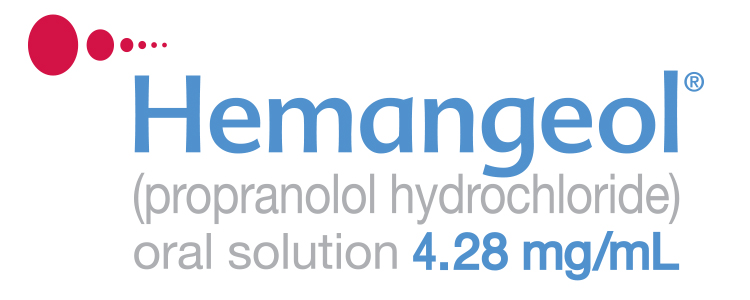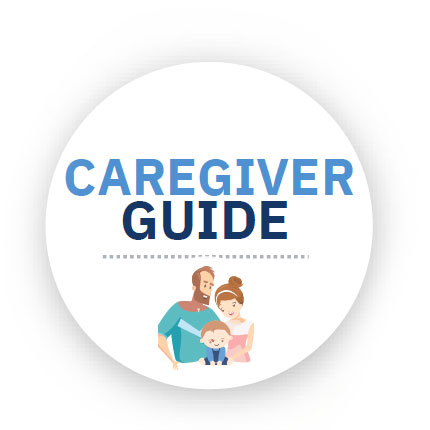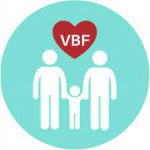Clinically Proven Safe and Effective
HEMANGEOL was studied in a primary clinical trial of 460 babies with proliferating (growing) hemangiomas (excluding life-threatening infantile hemangioma, function-threatening infantile hemangioma, and ulcerated infantile hemangioma with pain and lack of response to simple wound care measures).


HEMANGEOL Health & Safety
HEMANGEOL is a clear, colorless to slightly yellow oral-dosing solution supplied in a 120 mL amber glass bottle, with a child-resistant screw-cap. A specific oral syringe and syringe adapter are provided with each bottle. The oral dosing syringe measures HEMANGEOL according to volume in milliliters (mL).
HEMANGEOL is available in strawberry-vanilla flavor.
HEMANGEOL is:
- Alcohol-free
- Sugar-free
- Paraben-free
How HEMANGEOL Was Discovered
HEMANGEOL is a beta-blocker historically used for adult cardiovascular indications.
In 2007, while treating a baby for IH with oral steroids, the baby presented a cardiomyopathy (a complication of this treatment). Therefore, the child was treated with propranolol. Dr. Christine Léauté-Labreze and her colleagues discovered that propranolol hydrochloride (the active ingredient in HEMANGEOL) could also control the growth of hemangiomas. This discovery, along with the need for an approved treatment specifically formulated for babies, prompted the development of HEMANGEOL.

A Clinically Proven Treatment for Infantile Hemangioma
HEMANGEOL (propranolol hydrochloride) oral solution is clinically proven to effectively treat babies with proliferating (growing) infantile hemangioma that requires treatment with a medicine that spreads throughout the body.
Your doctor can explain risks associated with treatment, including low blood sugar (hypoglycemia), and common side effects. Talk to your doctor about questions you may have about the safety and efficacy or HEMANGEOL.
- 6 out of 10 of babies on HEMANGEOL had their infantile hemangioma lesion “completely or nearly completely resolved” by 6 months of therapy versus only 4% of babies given placebo (no treatment)
- Almost 9 out of 10 babies treated with HEMANGEOL showed improvement after 5 weeks1*
- Fewer than 2 out of 100 babies who were given HEMANGEOL had to stop treatment due to adverse experiences
- HEMANGEOL can cause serious side effects, including low blood sugar (hypoglycemia), especially if your child is not taking feedings, or is vomiting. The most common side effects include sleep problems, worsening respiratory tract infections, diarrhea, and vomiting. Please read additional Important Safety Information for HEMANGEOL.
- Function-threatening infantile hemangioma
- Infantile hemangioma in certain anatomical locations that often leave permanent scars or deformity
- Large facial infantile hemangioma
- Smaller infantile hemangioma in exposed areas
- Severe ulcerated infantile hemangioma
- Pedunculated infantile hemangioma
- Target lesions were resolved in 36% of patients by 3 months
How to Use HEMANGEOL
Give HEMANGEOL to your child exactly as your doctor tells you. Your doctor will determine the amount of HEMANGEOL your baby needs based on their weight. Your doctor may adjust the dose until it is right for your child, and as your child’s weight changes. You must give your baby the exact amount of HEMANGEOL that has been prescribed. Never change the amount you are giving your baby without the doctor’s direction.
HEMANGEOL is recommended to be given to your baby twice a day, once in the morning and once in the late afternoon, at least 9 hours apart.
Always use the specific oral dosing syringe provided with HEMANGEOL to give your baby the medicine directly into their mouth. Follow the detailed Instructions for Use that come with HEMANGEOL for information about how to prepare and give a dose of HEMANGEOL.
Always give HEMANGEOL with a feeding or right away after a feeding. HEMANGEOL is available in strawberry-vanilla flavor. If necessary, you can dilute the medicine in a small amount of milk or fruit juice and give it to your baby in their bottle.
If your child spits up a dose or if you are not sure your child got all of the medicine, do not give another dose. Wait until the next scheduled dose.
Giving HEMANGEOL to Your Baby
HEMANGEOL comes with a dedicated oral dosing syringe and syringe adapter for your convenience.
Please see the HEMANGEOL Instructions for Use to learn how to measure and administer HEMANGEOL.
The HEMANGEOL Caregiver Guide
The Caregiver Guide provides important information on how to recognize and to manage the following risks associated with the treatment with HEMANGEOL.
- Sugar (Hypoglycemia)
- Breathing Problems (Bronchospasm)
As with many drugs, HEMANGEOL may cause unwanted adverse effects.
These risks should be managed for the entire duration of treatment with Hemangeol for each child, including any retreatment.
Common questions about using HEMANGEOL:
In clinical trials, the age of babies starting the treatment was between 5 weeks and 5 months. Your doctor will determine the best age for your baby to start treatment.
In the clinical trial, HEMANGEOL was taken for 6 months. Only 10% of the baby’s required retreatment due to the infantile hemangioma coming back. Your doctor will decide how long your baby should be on therapy.
Your baby’s doctor will check to make sure your baby can tolerate HEMANGEOL by checking for slowing of the heart rate of low blood pressure up to 2 hours after the medicine is started or the dose is increased.
If for some reason, you need to get HEMANGEOL from a pharmacy, ask your doctor and arrangements can be made through HEMANGEOL Patient Access℠.
If your baby isn’t eating or is vomiting, you should skip the dose of HEMANGEOL because the medicine may mask the symptoms of hypoglycemia.
If your baby is not eating because of illness, is vomiting, or has diarrhea, you should not give HEMANGEOL until his or her feeding is back to normal. Once their appetite has returned, and vomiting, or diarrhea has passed, you can give the next planned dose after a meal.It’s important not to try and make up for missed doses of HEMANGEOL, because it could lead to overdosing.
If you aren’t sure whether your baby got the whole HEMANGEOL dose, don’t worry. There is no need to try and make up the dose. You should just wait until the next scheduled dose
If your baby has missed a dose, don’t worry. You don’t have to make up the dose and should wait until the next scheduled dose.
If your baby refuses to take HEMANGEOL through the oral dosing syringe, it can be mixed with a small amount of fruit juice or milk (breast or formula) suitable for your baby’s age. The mixture should be used within 2 hours. Do not mix HEMANGEOL with a full bottle of milk or fruit juice.
HEMANGEOL can cause serious adverse effects like hypoglycemia and make it more difficult to recognize the signs and symptoms. However, there are steps that you can take to reduce the risk.
HEMANGEOL should be given during or immediately after feeding to avoid hypoglycemia. Feed your baby regularly during treatment and tell your doctor if your baby has a poor appetite.
If necessary, you can add HEMANGEOL to a small amount of milk or juice. If your baby isn’t feeding due to an illness or vomiting, don’t give your baby the medicine until he or she is feeling normal again. It’s important to be aware of the signs of hypoglycemia, which include fast or irregular heartbeats, palpitations, sweating, irritability, sleepiness, and excessive hunger. If your baby shows any of these signs, call your doctor or go to the nearest emergency room right away.
The oral dosing syringe that comes in the HEMANGEOL box is specifically designed to measure the medicine. If you’ve lost or misplaced the syringe, contact HEMANGEOL Patient Access℠ toll free at 855-231-9522 for another one, before giving your baby the next HEMANGEOL dose.
For more information please visit our Parent Resources for Infantile Hemangioma.
Download the FAQ Guide of the Vascular Birthmarks Foundation using the button below. To learn more about the Vascular Birthmarks Foundation, visit their website.
The Vascular Birthmarks Foundation website is not owned or operated by Pierre Fabre. Links to all outside sites are provided as a resource only. Pierre Fabre accepts no responsibility or liability for the content or services of other websites.
Important Safety Information for HEMANGEOL
Do not give HEMANGEOL to your child if your child:
- was born prematurely and has not reached the corrected age of 5 weeks
- weighs less than 4 ½ pounds
- is allergic to propranolol or any of the other ingredients in HEMANGEOL
- has asthma or a history of breathing problems
- has a heart problem, slow heart rate (less than 80 heart beats per minute), very low blood pressure
- is at risk for low blood sugar, for example is vomiting or unable to take feedings
- has high blood pressure caused by a tumor on the adrenal gland, called “pheochromocytoma”
Tell your doctor about all of your child’s medical conditions, all of the medicines your child takes, and all of the medicines that you take if you are breastfeeding your child.
HEMANGEOL can cause serious side effects, including:
Low blood sugar (hypoglycemia), especially if your child is not taking feedings, or is vomiting. HEMANGEOL may make it more difficult to recognize the signs and symptoms of low blood sugar in your child. To help reduce the risk of low blood sugar with HEMANGEOL, give HEMANGEOL during or shortly after feeding your child. Feed your child regularly during treatment. Tell your doctor if your child has a poor appetite. If your child is not taking feedings, due to an illness or vomiting, do not give HEMANGEOL until your child is taking feedings normally again.
If your child has any of the signs or symptoms of low blood sugar listed below during treatment with HEMANGEOL, stop giving your child HEMANGEOL and call your doctor or go to the nearest emergency room right away.
Signs or symptoms of low blood sugar include: pale, blue or purple skin color, sweating, irritability, crying for no apparent reason, irregular or fast heartbeat, poor feeding, low body temperature, unusual sleepiness, seizures, breathing stops for short periods of time, and loss of consciousness
If your child is conscious, give him/her a drink of a liquid containing sugar.
Other serious side effects can include:
- New or worsening slow heart rate (bradycardia) or low blood pressure (hypotension).
- Breathing problems or wheezing.
- Stroke. HEMANGEOL may increase the risk of stroke in certain children who have severe problems with the blood vessels in their brain, particularly if your child has a large hemangioma that affects the face or head.
Call your doctor or go to the nearest hospital emergency room if your child has:
- pale skin color, slow or uneven heartbeats, arms or legs feel cold, blue or purple skin color, or fainting.
- breathing problems or wheezing during treatment with HEMANGEOL.
The most common side effects include: sleep problems, worsening respiratory tract infections, diarrhea, and vomiting.
These are not all the possible side effects of HEMANGEOL. Call your doctor for medical advice about side effects.
You are encouraged to report negative side effects of prescription drugs to the FDA. Visit www.fda.gov/medwatch or call 1-800-FDA-1088.
Please see Full Prescribing Information and Medication Guide.




